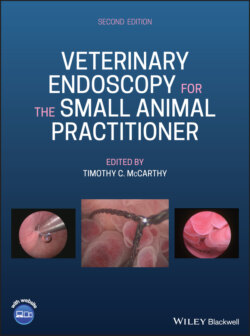Читать книгу Veterinary Endoscopy for the Small Animal Practitioner - Группа авторов - Страница 28
2.2.7 Irrigation Fluid Management Systems
ОглавлениеContinuous or intermittent irrigation is used for many diagnostic and operative endoscopy procedures. Intermittent irrigation with suction is used for laparoscopy and thoracoscopy. Continuous irrigation is used for cystoscopy, rhinoscopy, vaginoscopy, prepuceoscopy, transabdominal nephroscopy and ureteroscopy (TANU), transabdominal cholecystoscopy choledocoscopy and enteroscopy (TACCE), fistuloscopy, laceroscopy, oncoscopy, oculoscopy, analsacoscopy, and otoscopy. There are three different techniques used to maintain fluid flow: gravity flow using liter containers of fluid placed above the patient with an IV set connected to the fluid port on the telescope cannula; pressure‐assisted flow with a manual pressure cuff added to the gravity flow system; and automatic or manually controlled mechanical infusion pumps. Fluid inflow through the telescope cannula functions to distend structures for examination and to create a clear view by washing blood and debris away from the lens of the telescope out of the visual field. For most procedures, fluid outflow is simply through the naturally occurring space around the telescope sheath. For cystoscopy, outflow is either through the telescope sheath by intermittently stopping inflow and allowing outflow or with a double coaxial sheath allowing continuous simultaneous inflow and outflow. Laparoscopy and thoracoscopy use carbon dioxide for insufflation of distension to create a visual space with irrigation used for lavage and suction used to remove the fluid, blood, and any contaminants. Suction may also be used during otoscopy. Transabdominal procedures use suction to remove fluid from the abdomen but not from the abdominal organ being examined.
Lactated Ringer's solution, Ringer's solution, and physiologic saline solution are the most commonly used fluids. One‐, three‐, and five‐liter bags of sterile IV solutions are available for irrigation. The larger sized bags have the advantage of requiring less‐frequent container changes during procedures than smaller bags. Their disadvantages are that they are more cumbersome to handle than one‐liter bags and one‐liter containers are less expensive per liter than their larger counterparts.
